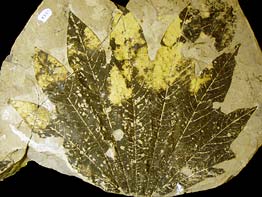Eocene fossils provide a glimpse of the futureStories from the collections I (page 1 of 2) |
||
|
The impact of global warming is understandably a topic of concern. Researchers
in numerous disciplines are using models to predict changes in sea level, ocean
currents, and climate and the effect that long-term warming will have on Earth’s
flora and fauna. It is difficult to determine the accuracy of these models unless
we wait hundreds or thousands of years to see if their predictions prove correct.
We can, however, learn from the past. By identifying a period in the past during
which there was a significant warming trend over a long period of time, we can
examine the fossil record prior to, during, and following that time interval, and
we can see the effects on biodiversity. Such a study of floral and faunal change
can serve as an independent test of hypotheses about the effects of warming today. The plants tell the climate story |
global warming and cooling throughout the Cenozoic. Today we expect to see small,
waxy leaves on plants growing in arid conditions and broad leaves on plants in
areas of high rainfall and warm temperature. Thus, leaf morphology (shape, size,
and thickness) provides information about temperature, precipitation, and other
environmental conditions. We can apply the same kind of general analysis to past
floras since we can infer that fossil plants lived under similar climatic
conditions as their living counterparts. Using this approach, early studies of
Eocene floras revealed that tropical to subtropical forests covered most of the
continental United States, while at higher latitudes, temperate conifer-hardwood
forests were dominant and reached well up into the Arctic Circle.
 Large palmate leaf of Macginitiea, an extinct sycamore from the Chalk Bluffs flora and a common element in many North American Eocene floras. (photo by Diane Erwin)
|
|